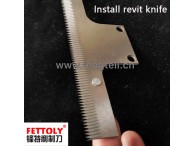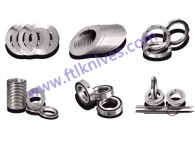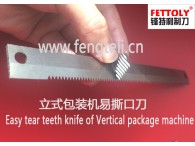News
High-Quality Food Blades for Efficient Food Processing
 In the fast-paced world of food processing, efficiency and precision are crucial. One key component that significantly impacts these aspects is food blades. These specialized blades are designed to cut, slice, chop, and dice ingredients with consistency and accuracy. Whether you're in a commercial kitchen, food manufacturing facility, or working with industrial food processors, understanding the importance of food blades can help optimize your operations. In this blog, we’ll explore the various types of food blades and their role in food processing.
In the fast-paced world of food processing, efficiency and precision are crucial. One key component that significantly impacts these aspects is food blades. These specialized blades are designed to cut, slice, chop, and dice ingredients with consistency and accuracy. Whether you're in a commercial kitchen, food manufacturing facility, or working with industrial food processors, understanding the importance of food blades can help optimize your operations. In this blog, we’ll explore the various types of food blades and their role in food processing.
What Are Food Blades?
Food blades are cutting tools specifically designed for the food processing industry. They are used to perform a wide range of cutting tasks, including slicing vegetables, meat, and even more delicate items like fruits and bread. These blades are made from durable materials such as stainless steel or specialized alloys to ensure longevity and prevent contamination.
Types of Food Blades
There are several types of food blades, each designed for specific functions. The right blade choice can improve speed, accuracy, and consistency in food preparation. Here are some common types:Slicing Blades
These blades are ideal for cutting uniform slices of fruits, vegetables, and meats. Precision slicing ensures uniformity, which is especially important for packaging or meal preparation.
Dicing Blades
Used for chopping food into small, uniform cubes, dicing blades are crucial in producing evenly sized pieces for salads, soups, and pre-packaged meals.
Shredding Blades
Shredding blades are used to break down food into thin strips, such as when shredding cheese, cabbage, or carrots for coleslaw or salads.
Julienne Blades
These blades cut food into long, thin strips, perfect for dishes like stir-fries or garnishes.
Why Choose the Right Food Blade?
Selecting the right food blade for the job is essential to achieve desired results in food processing. Here’s why choosing the right blade is important:Efficiency
A sharp, high-quality blade reduces the amount of time needed to prepare ingredients, helping increase production speed and throughput.
Consistency
Food blades ensure uniform cutting, which is important for both the appearance and quality of the final product.
Safety
A well-designed, properly maintained blade reduces the risk of accidents in food preparation areas, protecting both workers and consumers.
Maintaining Food Blades for Longevity
Proper maintenance of food blades is crucial to ensure they last longer and perform optimally. Some tips for maintaining food blades include:- Regular sharpening to maintain cutting efficiency.
- Cleaning blades after each use to prevent contamination.
- Storing blades in protective sheaths to avoid damage.
Conclusion
In the food processing industry, food blades are indispensable tools that improve efficiency, consistency, and safety. By selecting the right blade for the task, whether it’s slicing, dicing, or shredding, you ensure high-quality food products that meet the needs of both consumers and businesses. Proper maintenance also ensures these blades continue to perform at their best. Investing in quality food blades is essential for maintaining high standards in food production.












